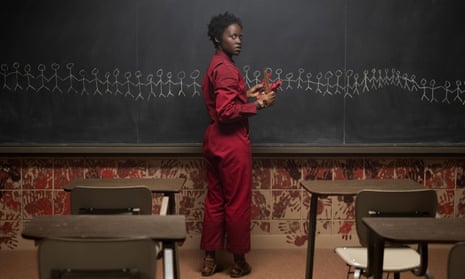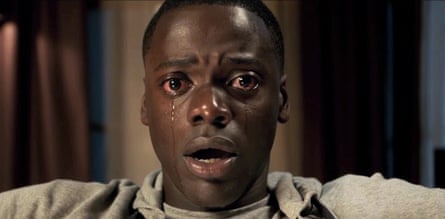 |
| Marina Enríquez |
Shock of the new: Jordan Peele, Mariana Enríquez and more on the horror fiction renaissance
There was a time, a few decades ago, when horror fiction meant just a few names. Stephen King and Dean Koontz in the US, James Herbert and Clive Barker in the UK. It was a boom time for sales but not critical recognition: a sea of paperbacks passed beneath school desks. And then, in the mid 90s, horror largely disappeared. Writers of darkness were repackaged into more market-friendly categories – thriller, dark fantasy, or that neutering, catch-all classification: suspense.
Now horror is emphatically back, and it is no longer a dirty word. Publishing imprints such as Titan and Nightfire are devoted almost entirely to the genre, small presses are helping to introduce new names, and a thriving online community of readers, writers, critics and commentators champion literature’s most sinister impulses.

Lupita Nyong’o in Jordan Peele’s 2019 horror film, Us.
A new US book is testament to this progress. Out There Screaming: An Anthology of New Black Horror is edited by film director Jordan Peele, who made Us and the electrifying Oscar-winner Get Out. Peele writes in his introduction: “I view horror as catharsis through entertainment. It’s a way to work through your deepest pain and fear.” But, he suggests, that isn’t possible for Black people “without the stories being told in the first place”.
For Peele, this collection, compiled with co-editor John Joseph Adams, was a chance to commission “the very best Black authors in fiction,” he tells me over email. “I hoped that, when prompted to create a personalised nightmare, their ‘monsters’ might be representative of some previously unnamed truths. What you get are stories that feel like they couldn’t or wouldn’t have been told a few years ago.”
NK Jemisin’s contribution examines police brutality through surrealistic body horror, while Tananarive Due imagines a moment from the civil rights movement that reads like an unearthed piece of folk history. But it’s interesting how many of the tales in Out There Screaming eschew overtly racialised horror – in particular, the tight focus on trauma that has long been a thorny issue in the Black horror community.

Peele tells me that before Get Out was released, “it it was quite possible that it would be accused of being reductively focused on trauma. Like, what if it was too triggering? To see the response be collectively cathartic: that was really rewarding. But what I love most is that the stories in Out There Screaming explore so many different worlds.”
The contributors run the gamut of Black speculative storytelling, from African-Caribbean fantasy to SF nightmares such as Lesley Nneka Arimah’s Invasion of the Baby Snatchers, in which aliens arrive not from the skies but through the wombs of pregnant women. It would be easy to read the story as riffing on racist fears of miscegenation, or as a bitter satire of “replacement theory”. However, such an interpretation risks confining Arimah’s wildly imaginative fiction to a singular metaphor.
“When the non-Black public engages with Black storytelling, there tends to be a focus on the Blackness as some sort of learning experience,” Arimah says. “It’s almost like they are telling you to ‘eat your vegetables’.”
Nnedi Okorafor agrees. “When we’re talking about the ‘Black experience’ what does that mean?” she asks me. “You can have stories that are about racism, but you can also have a story about a Black character just living their life, and living your life, those things come up.” In Okorafor’s story, Dark Home, a Nigerian-American woman is haunted by a spirit invoked at an Igbo masquerade. On her return to America, the juxtaposition of the ancient entity with her contemporary smart home mirrors her own conflicted identity. It’s a tension that vibrates more widely through the reading and writing of Black horror: the gravity of history pulling against the desire to embrace new stories.
Out There Screaming is a glorious showcase of Black American horror but the new canon is much wider. Victor LaValle, Zakiya Dalila Harris, Alexis Henderson, Johnny Compton and SA Cosby have each come to horror from different points on the literary compass. LaValle’s The Changeling is a horrific urban fairytale, while Harris’s The Other Black Girl is a scathing satire of workplace microaggressions that takes off on a Black Mirror-esque tangent into the fantastic. Cosby’s novel All the Sinners Bleed, meanwhile, blurs the boundaries between horror and crime with its story of a Black sheriff on the trail of a serial killer in a small town mired in prejudice and poverty. Cosby frames cruelty as a product of economic inequality as much as racial discrimination. As his sheriff explains: “Violence begets more violence and all violence is a confession of pain. Hurt people tend to hurt people.”
That universal truth is the undercurrent powering horror’s global eruption. So much fiction from outside Britain and the US is being written as a direct riposte to generations of hard imperialism, cultural hegemony or political trauma. This includes such distinct writing as Malaysian author Cassandra Khaw’s Nothing But Blackened Teeth, which subjects some obnoxious western tourists to a specifically east Asian supernatural torment, and Hungarian writer Attila Veres, whose collection The Black Maybe is almost aggressive in its rejection of traditional horror tropes.
In the UK, horror is tackling political pain with renewed urgency, too. In The Loney and Starve Acre, Andrew Michael Hurley distils the tension between rebellion and tradition into a new gothic, while Alison Rumfitt’s astonishing Tell Me I’m Worthless presents Britain as a haunted house, troubled by the unquiet spirits of fascism and prejudice.
For Bazterrica, the rise of Argentinian horror reflects a nation “riddled with violence, where the monstrous weight of state terrorism that tortured, killed and disappeared thousands of people is felt every day”. The memory of such institutional terror is ever present in Tender Is the Flesh, which depicts a world in which animal meat has been rendered inedible, leading to the implementation of state-sanctioned cannibalism. It’s a deeply upsetting blend of dystopian science fiction, social commentary and outright horror, a hybrid Bazterrica calls “getting out of the corset”.
Schweblin’s novel Little Eyes centres on our engagement with technology and capitalism, represented in the must-have “kentuki”. Part Furby, part Tamagotchi, these felt-covered digital pets infiltrate homes around the world. The kentuki’s camera provides a one-way mirror but the people who invite these cuddly companions into their personal spaces never know who is watching from inside. Little Eyes is a global story that considers the human cost of turning ourselves into spectacle and content. However, it is easy to also see in this techno-paranoia echoes of her nation’s recent history of oppression and state surveillance.
Mariana Enríquez is perhaps the most prominent writer of Latin American horror. English-language translations of her story collections Things We Lost in the Fire and The Dangers of Smoking in Bed brought her huge critical success abroad. Last year she released the epic horror saga Our Share of Night, which chronicles the barbarism of an occult order across decades. Enríquez makes no attempt to obscure the association between the awful power of her cult and Argentina’s military junta. The government overtly provides the order with “fresh alibis, bodies and currents of pain”.
Our Share of Night ricochets between a uniquely Argentinian horror and a more recognisable Anglo tradition. At times it reads like a Stephen King coming-of-age adventure transplanted to the streets of Buenos Aires. A section set in 60s London dips into English folk psychedelia, while another is haunted by the all-too-real death of 13-year-old Omayra Sánchez, killed by a landslide in Colombia. It’s a mashup of the expected and the unfamiliar that we can find, to some degree, in almost every area of the modern horror diaspora.
“We read King and Lovecraft and Poe and Jackson and the gothic,” Enríquez tells me, “but we work with our reality.”


No comments:
Post a Comment